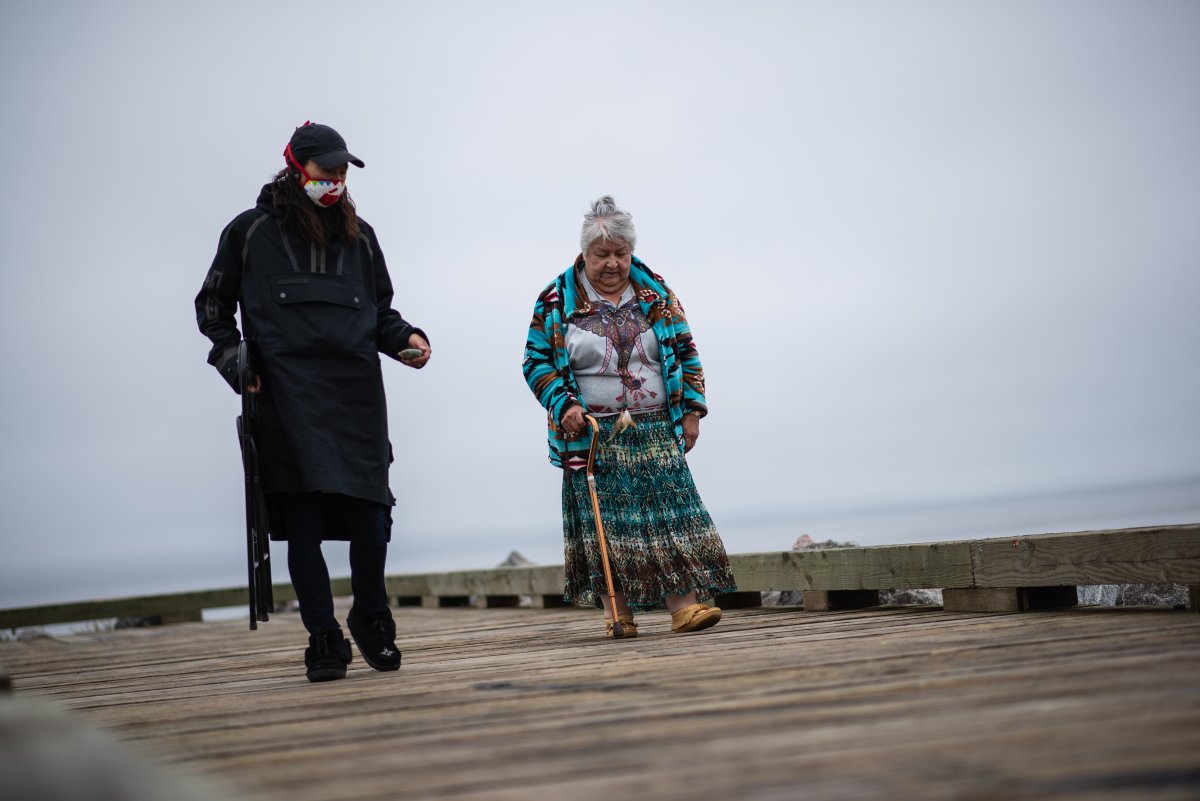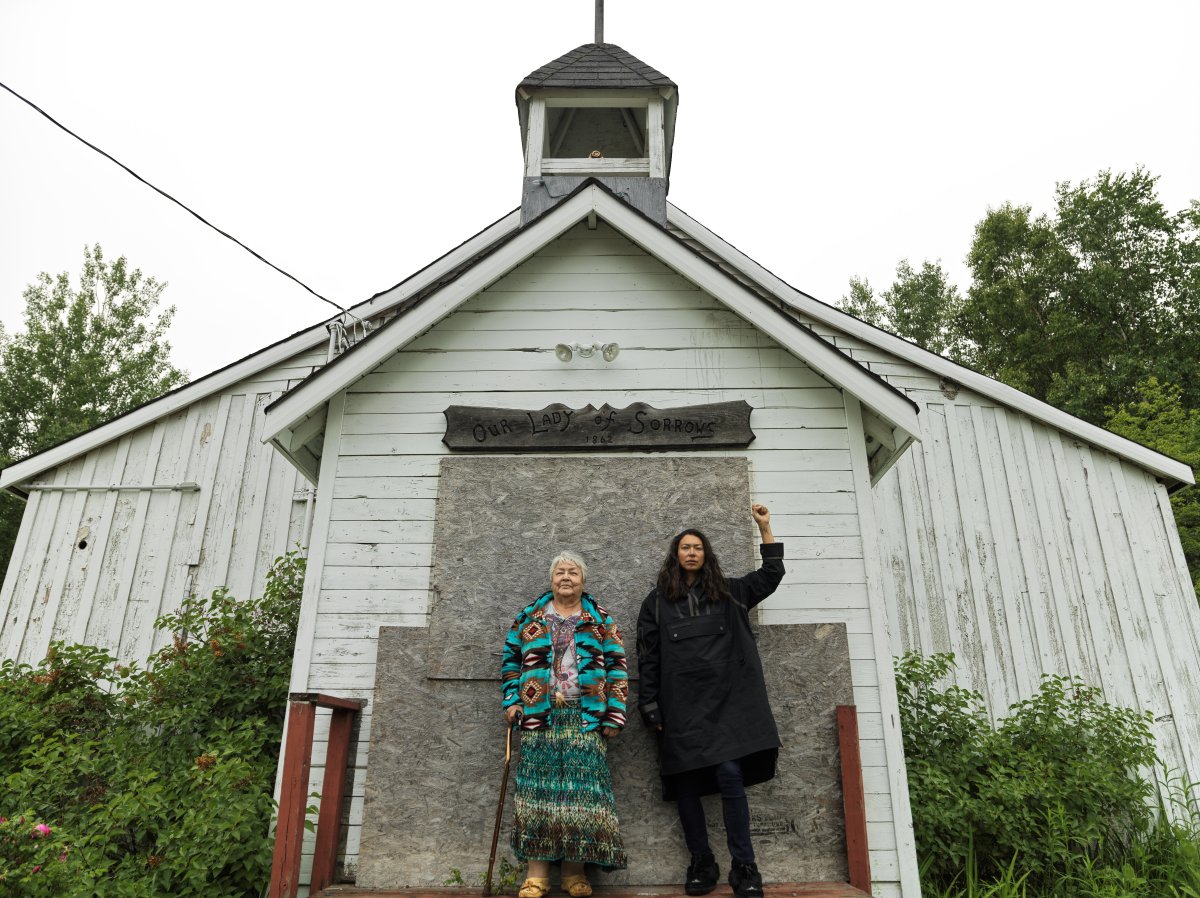Sarain Fox, best known as the Anishinaabekwe host of Rise on Viceland and Future History on APTN, released her directorial movie debut, Inendi, in early December. It’s a harrowing, emotional watch.
Inendi — the Anishinaabemowin word for “she is gone” — follows Fox as she travels to a remote Indigenous community in northern Ontario to sit with her Auntie Mary, a residential school survivor and the oldest matriarch in Fox’s family. As COVID-19 infiltrates Indigenous communities, Fox eagerly travels to Mary to gather the elder’s stories and preserve her cultural legacy as the pandemic threatens to take her.
The documentary was produced entirely by an Indigenous-led crew (a rarity in Canada) under Fox’s own company, Land Back Studios. Filled to the brim with emotion, Inendi is not for the faint of heart.
This is about as raw as it gets. Fox’s gift for storytelling culminates in a gut-punch final scene where she confronts the camera head-on, an incredibly poignant moment.
Global News spoke with Fox about her first-ever film, and what she hopes audiences will take from it.

Sarain Fox and her Auntie Mary walk along the shore in ‘Inendi.’.
Land Back Studios, Inc.
Global News: This doc is powerful. When you started shooting the project, did you know how deep it was going to get? How deep you were going to get?
Sarain Fox: From the start, I knew that this would be a really emotional and intense experience; mostly for my auntie, I assumed. I did not expect to be so raw and vulnerable myself. In fact, most of the direct-to-camera footage was intended as a guide track for my (amazing) editor. I just let it all out and much of that unfiltered emotion was kept.
The entire crew of Inendi is Indigenous, a shamefully rare thing in Canada (the world, too?). Did that feel empowering and add to the legitimacy of the doc?
My crew was incredibly diverse — majority female and majority Indigenous. I led the project as director, and it felt really good to hire a young Indigenous creative for their first full-length movie as a camera operator. Her name is Sage Petahtegoose and I’ve known her since she was a youth.
I worked with trusted collaborators who were all committed to uplifting my auntie’s story. For that, I have utmost gratitude. I believe it has never been more important for Indigenous storytellers to tell their own stories.
COVID-19 has become a real danger for Indigenous communities, especially the more isolated ones. What was it like shooting during the pandemic?
Shooting during a pandemic comes with incredible responsibility. It wasn’t that long ago that diseases, introduced by settlers (often intentionally), created havoc in our communities and decimated Indigenous populations, so there was a real sense of risk. I took the protection of my auntie and the community members seriously. It informed every part of the story (in front of and behind the lens).
As shown in your doc, the loss of an elder is so much more than just death. It’s the passing away of stories and legacy. How can all Canadians (including non-Indigenous) help preserve this precious knowledge?
Our elders are our knowledge keepers; they hold our legacies, our truth. Find the space and time to sit and listen. It’s special to have the chance to record what they want to pass down and make a plan together. I’m glad I was able to make my auntie’s dream a reality. Anyone can do this with the tools they have available. Taking the time is what really matters.
Read more:
Tonya Williams, former ‘Y&R’ star, launches Access Reelworld to help racially diverse Canadians
Something non-Indigenous people, including myself, are probably unaware of is this immense pressure to preserve your culture while simultaneously trying to “live your life” as you see fit. You also live with generational trauma. Every day, you are forced to find that balance. How do you cope with this and how do you deal with the mental struggle that must come along with it?
I use my platform to uplift and amplify Indigenous voices. I do this work in every interaction and with every job I take. I make a choice to take up space in the mainstream and bring my community with me. Our individual perspectives are as important as our shared truths. Every single comment, narrative choice, business meeting, Instagram post — everything I do — is informed by a responsibility to my community.
Auntie Mary’s description of life at a residential school is horrific from start to finish. Why do so many Canadians either a) not know about them at all or b) refuse to accept how barbaric/racist/inhumane they were?
I am often shocked by the reactions of Canadians to the extreme abuse inflicted on Indigenous peoples. There has been a purposeful narrative created by the Canadian government that frames Indigenous people as a burden to the system. We don’t teach the truth in schools or inform Canadians of the true history of this country and how the treaties work and how settlers work within them.
It is hard to acknowledge the truth when it may affect your own privilege or destabilize your family legacy. I challenge Canadians to consider how land ownership and capitalism have contributed to Indigenous genocide.
The good news is, like auntie Mary says, Indigenous people “don’t die.” Does the idea that your elders live on all around you, even after physical death, provide any comfort?
My teachings are my foundation and world-view. We believe that when you pass on, your spirit can still come back and visit. We feast our dead, take care of them, acknowledge them. This makes the grief of loss easier to bear. We believe our ancestors are always with us.
Read more:
Remembering the celebrities we lost in 2020
You’re using your art as both a weapon and a tool — a weapon in that it’s effective and really sends a message for change, and a tool in that there’s growth for people unaware, as well as a method of keeping your culture alive. I love this. Do you plan on continuing using your art in this manner?
I love this question! Yes! I will always use my art and my voice to create meaningful change in any way I can. I believe that it is the artist’s role to shine light in new and innovative ways on the state of our collective humanities.
How many roadblocks have you personally faced, being an Indigenous person in the arts? Have you noticed any changes as you’ve gathered more experience, or does it always stay the same?
Since I was a youngster, dreaming of dancing as a principal with the national ballet, I have had to fight to belong in a room full of colonial voices. I was too brown, too educated in our truth, too loud, too unruly… not colonized. If you stand up for your truth, you are automatically a target of those who want to be complacent to harm.

Auntie Mary (L) and Sarain Fox pose in ‘Inendi.’.
Land Back Studios, Inc.
This is the same today. There has been tremendous work in the right direction — like the creation of the Indigenous Screen Office and the innovative work being done with imagiNATIVE. There is good work happening.
As long as authentic Indigenous voices are at the table, in the front row, behind the camera and signing the contracts, we will continue to change the industry (and perhaps the Canadian landscape of filmmaking and storytelling).
What message do you hope to send to audiences with Inendi?
Take the time to sit with your elders and listen.
——
You can watch ‘Inendi’ in its entirety on YouTube.
© 2020 Global News, a division of Corus Entertainment Inc.


